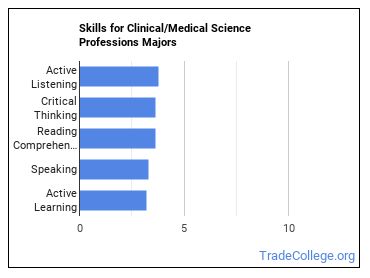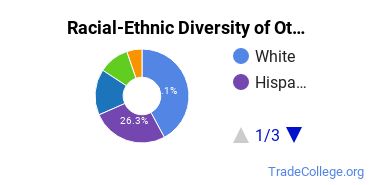Find Trade Colleges
Other Clinical/Medical Laboratory Science and Allied Professions
Types of Degrees Other Clinical/Medical Laboratory Science and Allied Professions Majors Are Getting
The following table lists how many other clinical/medical laboratory science and allied professions graduations there were in 2021-2022 for each degree level.
| Education Level | Number of Grads |
|---|---|
| Bachelor’s Degree | 574 |
| Basic Certificate | 57 |
| Undergraduate Certificate | 38 |
| Associate Degree | 9 |
What Other Clinical/Medical Laboratory Science and Allied Professions Majors Need to Know
People with careers related to other clinical/medical laboratory science and allied professions were asked what knowledge areas, skills, and abilities were important for their jobs. They weighted these areas on a scale of 1 to 5 with 5 being the highest.
Knowledge Areas for Other Clinical/Medical Laboratory Science and Allied Professions Majors
This major prepares you for careers in which these knowledge areas are important:

- Biology - Knowledge of plant and animal organisms, their tissues, cells, functions, interdependencies, and interactions with each other and the environment.
- English Language - Knowledge of the structure and content of the English language including the meaning and spelling of words, rules of composition, and grammar.
- Chemistry - Knowledge of the chemical composition, structure, and properties of substances and of the chemical processes and transformations that they undergo. This includes uses of chemicals and their interactions, danger signs, production techniques, and disposal methods.
- Medicine and Dentistry - Knowledge of the information and techniques needed to diagnose and treat human injuries, diseases, and deformities. This includes symptoms, treatment alternatives, drug properties and interactions, and preventive health-care measures.
- Customer and Personal Service - Knowledge of principles and processes for providing customer and personal services. This includes customer needs assessment, meeting quality standards for services, and evaluation of customer satisfaction.
Skills for Other Clinical/Medical Laboratory Science and Allied Professions Majors
A major in other clinical/medical laboratory science and allied professions prepares you for careers in which the following skill-sets are crucial:

- Active Listening - Giving full attention to what other people are saying, taking time to understand the points being made, asking questions as appropriate, and not interrupting at inappropriate times.
- Critical Thinking - Using logic and reasoning to identify the strengths and weaknesses of alternative solutions, conclusions or approaches to problems.
- Reading Comprehension - Understanding written sentences and paragraphs in work related documents.
- Speaking - Talking to others to convey information effectively.
- Active Learning - Understanding the implications of new information for both current and future problem-solving and decision-making.
Abilities for Other Clinical/Medical Laboratory Science and Allied Professions Majors
Some of the most crucial abilities to master while a other clinical/medical laboratory science and allied professions student include the following:

- Near Vision - The ability to see details at close range (within a few feet of the observer).
- Problem Sensitivity - The ability to tell when something is wrong or is likely to go wrong. It does not involve solving the problem, only recognizing there is a problem.
- Oral Comprehension - The ability to listen to and understand information and ideas presented through spoken words and sentences.
- Finger Dexterity - The ability to make precisely coordinated movements of the fingers of one or both hands to grasp, manipulate, or assemble very small objects.
- Written Comprehension - The ability to read and understand information and ideas presented in writing.
What Can You Do With a Other Clinical/Medical Laboratory Science and Allied Professions Major?
Below is a list of occupations associated with other clinical/medical laboratory science and allied professions:
| Job Title | Job Growth Rate | Median Salary |
|---|---|---|
| Cytogenetic Technologists | 11.6% | NA |
| Cytotechnologists | 11.6% | NA |
| Histotechnologists and Histologic Technicians | 11.6% | NA |
| Medical and Clinical Laboratory Technicians | 14.0% | NA |
Other Related Clinical/Medical Science Professions Programs
Learn about start dates, transferring credits, availability of financial aid, and more by contacting the universities below.
Take your associate degree in an allied health field to the next level with this specialized transfer friendly online bachelor of science from Southern New Hampshire University.
Who Is Getting an Associate’s Degree in Other Clinical/Medical Laboratory Science and Allied Professions?
Racial-Ethnic Diversity
At the countrywide level, the racial-ethnic distribution of other clinical/medical laboratory science and allied professions majors is as follows:

| Race/Ethnicity | Number of Grads |
|---|---|
| Asian | 1 |
| Black or African American | 1 |
| Hispanic or Latino | 3 |
| White | 4 |
| International Students | 0 |
| Other Races/Ethnicities | 0 |
Amount of Education Required for Careers Related to Other Clinical/Medical Laboratory Science and Allied Professions
Some careers associated with other clinical/medical laboratory science and allied professions require an advanced degree while some may not even require a bachelor’s. In general, the more advanced your degree the more career options will open up to you. However, there is significant time and money that needs to be invested into your education so weigh the pros and cons.
How much schooling do you really need to compete in today’s job market? People currently working in careers related to other clinical/medical laboratory science and allied professions have obtained the following education levels.

| Education Level | Percentage of Workers |
|---|---|
| High School Diploma - or the equivalent (for example, GED) | 3.5% |
| Post-Secondary Certificate - awarded for training completed after high school (for example, in agriculture or natural resources, computer services, personal or culinary services, engineering technologies, healthcare, construction trades, mechanic and repair technologies, or precision production) | 3.1% |
| Some College Courses | 1.0% |
| Associate’s Degree (or other 2-year degree) | 23.6% |
| Bachelor’s Degree | 43.2% |
| Post-Baccalaureate Certificate - awarded for completion of an organized program of study; designed for people who have completed a Baccalaureate degree but do not meet the requirements of academic degrees carrying the title of Master. | 19.7% |
| Master’s Degree | 2.8% |
| Post-Master’s Certificate - awarded for completion of an organized program of study; designed for people who have completed a Master’s degree but do not meet the requirements of academic degrees at the doctoral level. | 0.8% |
| First Professional Degree - awarded for completion of a program that: requires at least 2 years of college work before entrance into the program, includes a total of at least 6 academic years of work to complete, and provides all remaining academic requirements to begin practice in a profession. | 0.8% |
| Post-Doctoral Training | 0.8% |
Online Other Clinical/Medical Laboratory Science and Allied Professions Programs
The following table lists the number of programs by degree level, along with how many schools offered online courses in the field.
| Degree Level | Colleges Offering Programs | Colleges Offering Online Classes |
|---|---|---|
| Certificate (Less Than 1 Year) | 0 | 0 |
| Certificate (1-2 years) | 10 | 0 |
| Certificate (2-4 Years) | 0 | 0 |
| Associate’s Degree | 6 | 0 |
| Bachelor’s Degree | 6 | 0 |
| Post-Baccalaureate | 0 | 0 |
| Master’s Degree | 11 | 1 |
| Post-Master’s | 0 | 0 |
| Doctor’s Degree (Research) | 1 | 0 |
| Doctor’s Degree (Professional Practice) | 0 | 0 |
| Doctor’s Degree (Other) | 0 | 0 |
Explore Major by State
Alabama
California
District of Columbia
Idaho
Kansas
Maryland
Mississippi
Nevada
New York
Oklahoma
South Carolina
Utah
West Virginia
Alaska
Colorado
Florida
Illinois
Kentucky
Massachusetts
Missouri
New Hampshire
North Carolina
Oregon
South Dakota
Vermont
Wisconsin
Trades Related to Other Clinical/Medical Laboratory Science and Allied Professions
You may also be interested in one of the following majors related to other clinical/medical laboratory science and allied professions.
References
*The racial-ethnic minorities count is calculated by taking the total number of students and subtracting white students, international students, and students whose race/ethnicity was unknown. This number is then divided by the total number of students at the school to obtain the racial-ethnic minorities percentage.
- College Factual
- College Scorecard
- National Center for Education Statistics
- O*NET Online
- U.S. Bureau of Labor Statistics
- Usual Weekly Earnings of Wage and Salary Workers First Quarter 2020
- Image Credit: By Staff Sgt. Jerilyn Quintanilla under License
More about our data sources and methodologies.

